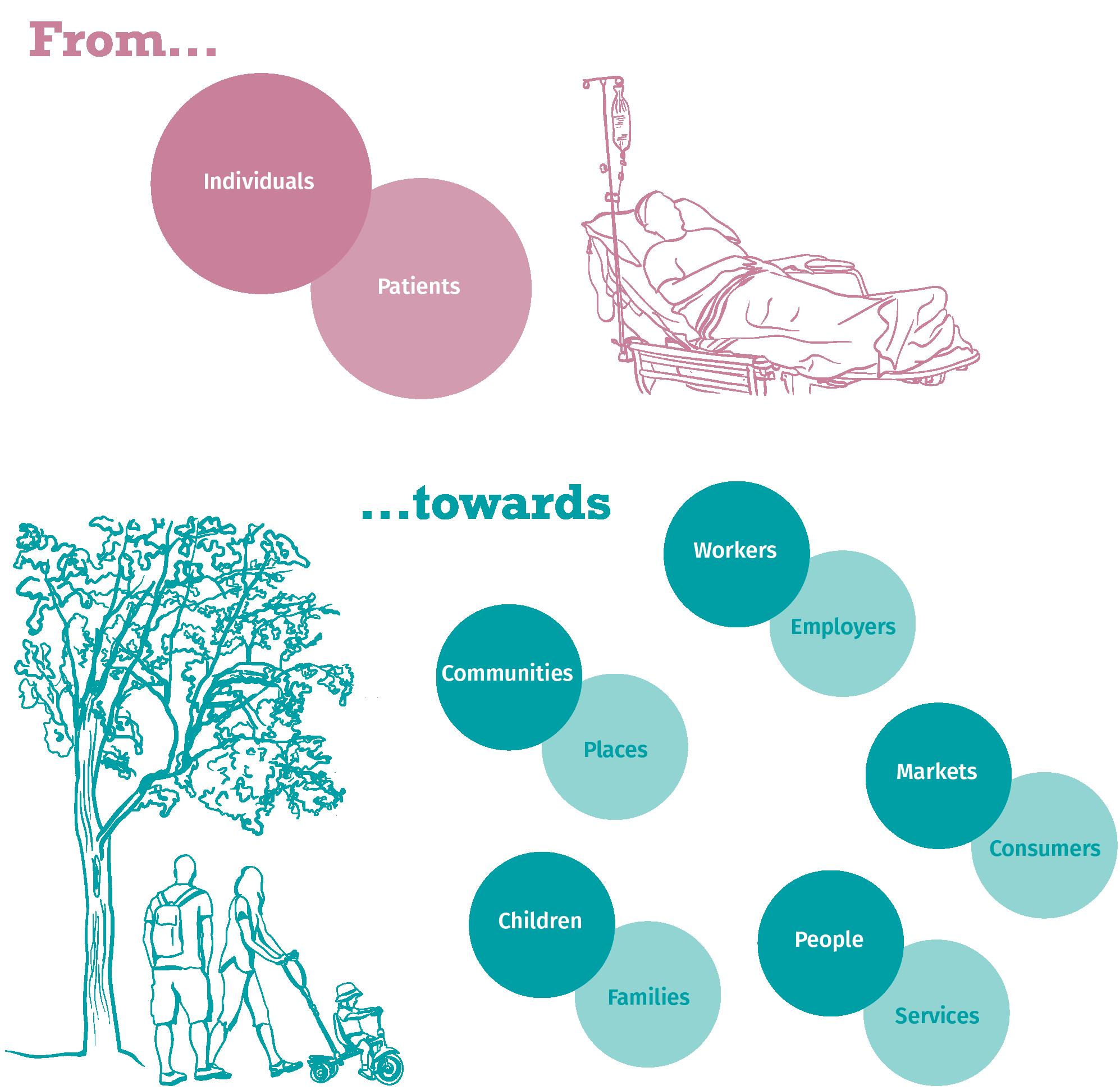OUR GREATEST ASSET
FINAL REPORT OF THE COMMISSION ON HEALTH AND PROSPERITY
SUMMARY REPORT
Chris Thomas, Jamie O'Halloran, Henry Parkes, Annie Williamson, Parth Patel, Efua Poku-Amanfo, Dave Hawkey and Harry Quilter-Pinner September 2024


FINAL REPORT OF THE COMMISSION ON HEALTH AND PROSPERITY
SUMMARY REPORT
Chris Thomas, Jamie O'Halloran, Henry Parkes, Annie Williamson, Parth Patel, Efua Poku-Amanfo, Dave Hawkey and Harry Quilter-Pinner September 2024

Professor Dame Sally C Davies (chair), Master, Trinity College Cambridge, former chief medical officer for England
Lord James Bethell, former health minister
Matthew Taylor, chief executive, NHS Confederation
Professor Donna Hall CBE, chair, New Local
Marie Gabriel CBE, chair, NHS Race and Health Observatory
Kieron Boyle, chief executive, Impact Investing Institute
Jordan Cummins, health director, Confederation of British Industry
Kamran Mallick, chief executive officer, Disability Rights UK
Dr Charmaine Griffiths, chief executive officer, British Heart Foundation
Anna Garrod, policy and influencing director, Impact on Urban Health
Sophie Howe, former future generations commissioner, Wales
Professor Lord Ara Darzi (chair), Paul Hamlyn chair of surgery, Imperial, former health minister
Andy Burnham, mayor of Greater Manchester
John Godfrey, managing director, The City UK
Professor Clare Bambra, professor of public health, Newcastle University
Christina McAnea, general secretary, Unison
Dr Jonathan Pearson-Stuttard (vice chair), chair, RSPH
Dr Halima Begum, chief executive officer, Oxfam GB
Dr Fiona Carragher, director of research, Alzheimer’s Society
Professor Simon Wren-Lewis, professor of economics, Oxford University
Tom Kibasi (vice chair), senior vice president of strategy, Flagship Pioneering
For more information about the Institute for Public Policy Research, please go to www.ippr.org
You can also e-mail info@ippr.org or find us on X @ippr
Institute for Public Policy Research
Registered Charity no. 800065 (England & Wales), SC046557 (Scotland), Company no, 2292601 (England & Wales)
Chris Thomas is head of the Commission on Health and Prosperity at IPPR.
Jamie O'Halloran is a senior research fellow at IPPR.
Henry Parkes is principal economist and head of quantitative research at IPPR.
Annie Williamson is a research fellow at IPPR.
Parth Patel is a principal research fellow at IPPR.
Efua Poku-Amanfo is a research fellow at IPPR.
Dave Hawkey is a senior research fellow at IPPR Scotland.
Harry Quilter Pinner is interim executive director at IPPR.
This report advances IPPR’s charitable objective of advancing physical and mental health.
The authors would like to thank Emma Killick, Abi Hynes, Richard Maclean, David Wastell, Liam Evans, Georgia Horsfall and Ashwin Kumar at IPPR for their contributions to this report. We'd also like to thank Piers Ford for editing the report, and all the commissioners, research participants, experts and stakeholders that have contributed to the commission in the last three years.



Download






This document is available to download as a free PDF and in other formats at: http://www.ippr.org/articles/our-greatest-asset
Citation
If you are using this document in your own writing, our preferred citation is: Thomas C, O'Halloran J, Parkes H, Williamson A, Patel P, Poku-Amanfo E, Hawkey D and Quilter-Pinner H (2024) Our greatest asset: Final report of the Commission on Health and Prosperity – summary, IPPR. http://www.ippr.org/articles/our-greatest-asset
Permission to share
This document is published under a creative commons licence: Attribution-NonCommercial-NoDerivs 2.0 UK http://creativecommons.org/licenses/by-nc-nd/2.0/uk/ For commercial use, please contact info@ippr.org
The term the ‘sick man of Europe’ is often used to describe countries going through severe economic turmoil or social unrest. In Britain, today, it has become a more literal reality. We lag our peers on health outcomes, the number of people with a long-term condition is rising, and people are spending longer proportions of their lives in poor health. In fact, health is worsening throughout the life course – bringing real challenges for children, adolescents, working age adults and those who have retired.
That is, the nation’s health challenges have reached historic proportions. Change is needed. Led by an understanding that the boldest health reforms only come when there is a strong social and economic case for them, this commission has spent the last three years testing one, simple idea: that better health is Britain’s greatest untapped route to prosperity.
At a time when pessimism would be easy, this – the final report of the IPPR Commission on Health and Prosperity – finds that better health is exactly the medicine our economy needs. Reporting on three years of analysis, qualitative work, commissioner debate and stakeholder engagement, we find that better health could help meet the UK’s biggest, specific economic challenges.
• Labour supply: We find that 900,000 workers were missing from work due to sickness – compared to what we would have otherwise expected on prepandemic trends – at the end of 2023. Economic inactivity due to sickness could breach 4 million by the end of the parliament, if post-pandemic trends continue.
• Productivity: People with one or multiple health conditions are as much as twice as likely to take sick days or experience lower productivity due to working through sickness. Productivity impact of sickness is linked to to poor job design, work culture or financial means to take sick days when they are needed.
• Earnings: Better health has the potential to significantly boost people’s earnings, after nearly two decades of stagnant real wage growth. Indicatively, we find that avoiding a preventable long-term condition is worth up to £2,200 in annual earned income.
• Public finances: Poor health means avoidable expenditure in the NHS and welfare system, and lower tax receipts (as fewer people are in work). We find that the 900,000 missing workers due to sickness (above) mean a loss of an estimated £5 billion in tax receipts per year, and that better population health could save the NHS £18 billion per year by the mid-2030s.
• Regional balance: The UK is a highly unbalanced economy – with growth, disposable income and productivity concentrated in London and the South East. We find better health would benefit the economy everywhere but would disproportionately boost the labour market and wages in the North of England and Wales.
Put simply, if the UK needs new and innovative strategies to revitalise the economy, then we contend that better health could be exactly the strategy required. And in reducing the costs associated with sickness, we could also build a fairer, more inclusive and happier nation.
We will not revitalise the health of the nation by persisting with today’s health policy status quo. Demonstrably, our current approach is not leading to healthier
lives. This report’s central contention is that better health will only be possible if we move from a sickness model of health policy to a health creation one. It is achieving this shift that should define the implementation of the new government’s health mission.
We define the sickness model as one in which government avoids intervention while people are ‘well’ – instead, considering ‘health’ a matter of personal responsibility – and that only decisively intervenes once someone experiences highly acute need (i.e. through the NHS, at the ‘point of delivery’). This might have been appropriate when need was often acute, but today it severely limits our scope for health creation and our ability to meet the defining health challenges of the 21st century: chronic conditions, multiple morbidity, worse mental and social health outcomes, and higher proportions of lives spent in sickness.
A health creation system would make healthier lives a cross-society, crosseconomy mission – and would focus intervention on the places where people really spend their time. While we might spend a few weeks or months of our lives in hospitals, we’ll spend tens of thousands of hours in work, thousands of hours in schools, and most of our time in our homes, communities and with friends or loved ones. It is in and through these spaces that a health creation system should be founded, which would support us through our lives – from ‘cradle to grave’, rather than just ‘at cradle’ and ‘at grave’.
We set out five foundational pillars for a new, British health creation system – as bold a health agenda for the 21st century’s specific challenges, as the NHS was for the 20th.
From work that harms health...
From tolerating health harms...
...to work that creates it
...to an active industrial strategy for health
From waiting for sickness... ...to health creation at the start of life
From places that make us sick... ...to empowered, healthy communities
1 2 3 4 5
From reactive services... ...to preventative, primary care-led healthcare
Progress could be measured through an expanded version of the ‘health index’ –playing the equivalent role for health that GDP does for the economy.
This paper is an abridged version of the final report of the Commission on Health and Prosperity. It draws from the key analysis of the commission to date. A fuller account of the evidence for our assessment of Britain, on the value of health and on our policy proposals can be found in the full final report.

The ‘sick man of Europe’ is a phrase often used describe nation states experiencing severe economic or social unrest. In 21st century Britain, it has become a more literal reality. On a range of indicators and measures, Britain is doing worse on health than other, comparable countries.
FIGURE 1.1
The UK lags other comparable countries on health outcomes Health scorecard, G7 nations, 2023 or latest data
Life expectancy Health spending
Children in relative poverty Gini coe cient
Source: IPPR analysis of OECD 2024a, 2024b and IHME 2024
Britain is also getting sicker in absolute as well as relative terms. The UK is experiencing a sharp rise in the prevalence of many long-term conditions. This is not solely about population ageing: indeed, children, teenagers and working age people are also getting sicker, as well as people in retirement.
FIGURE 1.2
The number of people with a health condition is rising – most sharply among the working age population
Proportion of adults aged 30 – 69, with a long-term health condition, 2010, 2019, 2030 and 2040
Source: IPPR analysis of Watt et al 2024
This trajectory is not set in stone. Much of Britain’s ‘disease burden’ is avoidable – whether through prevention or treatment. And even when it is not, designing services and society around the needs of people with long-term conditions and disabled people could enable us to do much better on ensuring people have every chance of a healthy, happy, prosperous life.
TABLE 1.1
Many health conditions can be prevented. Others can be more effectively and quickly treated, or better managed
Proportion of disease burden causally attributable to known risk factors, select major conditions, UK, 2023
Source: IPPR analysis of IHME 2024
Worse health has wide ranging consequences – on our individual lives, and on our community and national institutions.1 Perhaps most obviously, it means many more of us are waiting – and waiting longer – for the healthcare we need. More sickness means more NHS pressure. And in the last decade, that has been visible in rising queues for elective and emergency care, diagnostic tests and a range of life saving treatments are on the up.
FIGURE 1.3
Demand for NHS services is rising, putting it under increasing pressure Index of selected NHS demand indicators, 12 month rolling average, Index 100 = July 2011, England
Waiting times and activity for diagnostic tests and procedures
Number waiting more than 18 weeks with estimates for missing data
Source: IPPR analysis of NHS Digital 2024a, 2024b, 2024c
Total attendances more than four hours
But the impact of sickness is not just limited to our experience of healthcare. In lieu of better health and employment support, rising sickness has led to more people leaving work. And that has meant a sharp rise in the number of people in receipt of health-related benefits – across the entire working age population.
1 We do not ascribe this cost to people’s difference but rather – in keeping with the social model of disability – to how structured our society is to prevent need where it is avoidable, and to ensure flourishing, prosperous lives for disabled people and people with long-term conditions.
FIGURE 1.4
Numbers receiving health-related benefits are rising at every age Share of population receiving any health-related benefit by age in 2019 and 2023 in England and Wales
November 2019 November 2023
Note: Health benefits included are personal independence payment, disability living allowance, attendance allowance, UC-health, employment and support allowance, incapacity benefit, severe disablement allowance, and income support for those claiming on the basis of incapacity.
Source: IPPR analysis of DWP 2024 and ONS 2024a
But it is not just that sickness is forcing more people out of work – people in work are also sicker. People in all kinds of work and workplaces are more likely to have a long-term condition that just a decade ago. And in some parts of the economy, there is very little support or adaptation for their health needs.
FIGURE 1.5
Sickness is rising in-work – not just among people outside it
Estimates of the expected number of people working with long-term conditions by company size
Source: IPPR analysis of ONS 2024b
Children are also facing more health challenges. In recent years, children have been facing worsening physical and mental health – we are seeing increasing rates of obesity, and mental health problems. This can undermine school attendance, learning and exam results – that is, it can have a lifelong impact on opportunity and aspiration.
FIGURE 1.6
Mental health is getting worse among children and young people
Proportion of children with a possible or probably mental health condition in England
Source: IPPR analysis of NHS digital 2023
FIGURE 1.7
Obesity rates continue to increase among children
Proportion of children living with obesity or overweight, England 2006-22
Britain has been getting sicker in the last 15 years – but it has also been getting poorer. Alongside the worsening health of the nation, Britain has deep-seated economic challenges: low growth, stagnant productivity, depressed wages, falling living standards and (more recently) falling workforce participation rates. Our contention is this: our concurrent health and economic challenges are not simple coincidence.
Real wages are £14,000 lower today than they would have been if pre-2008 financial crash trends continued. Our commission has found that the falling sick leads to a fall in annual earned income of up to £2,200

FIGURE 1.8
The onset of sickness impacts people’s annual earned income
Regression analysis of impact of a long-term health condition or mental illness on individual and household earnings 2014-2019
Source: IPPR analysis of ISER 2023
The UK labour market has been uniquely impacted by Covid-19. Where most other nations have recovered, participation in work in the UK has not returned to pre-pandemic levels. There are as many as 900,000 ‘missing workers’ due to sickness now, compared to where we’d have expected to be.
FIGURE 1.9

Economic inactivity due to sickness has risen sharply compared to what we’d have expected on pre-pandemic trends
Excess economic inactivity since 1999 (compared to previous trajectories)
1,000,000
Source: IPPR analysis of ONS 2024b -200,000 0 200,000 400,000 600,000 800,000
Since the 2008 global financial crisis, annual productivity growth has been about half what it was before the financial crash. This commission has found people in work are getting sicker, and that this impacts both their productivity in work – and their likelihood of taking sick days.

FIGURE 1.10
Excess vs pre-Covid-19 trend
The onset of a health condition has a productivity impact at work
The predicted number of hours of sick leave taken per week by sex and type of long-term condition
Source: Recreated from IPPR analysis in O’Halloran and Thomas (forthcoming)
In Britain, growth and wealth are concentrated in London. Health inequality is a major reason why other regions and nations have lower growth, lower productivity, less opportunity and weaker labour markets.

FIGURE 1.11
Economic and health inequality cluster in much the same places Index of poor health and levels of economic inactivity
Source: Recreated from Poku-Amanfo et al 2024
Britain has inherited a model of health policy from the 20th century - one we call ‘the sickness model’. Under it, health is considered predominantly a matter of personal responsibility before we get sick – with intervention limited to moments of acute need. This reactive approach leaves the NHS to ‘go it alone’. One consequence of this approach has been a long-term concentration of government expenditure in the NHS: its budget has increased twelvefold since it was founded.
FIGURE 1.12
The NHS’ share of government expenditure has risen Share of total government expenditure explained by selected public services
1978/791980/811982/831984/851986/871988/891990/911992/931994/951996/971998/992000/012002/032004/052006/072008/092010/112012/132014/152016/172018/192020/212022/23 Health Education Defence Public order and safety Transport
Source: IPPR analysis of IFS 2023
Healthcare is vital to our health. We should strive to give people the fastest access to the most innovative medicines, treatments and diagnostics possible. But we should also recognise more NHS funding and more NHS staff – alone – has not meant better health in the 20th century.
FIGURE 1.13
In the 21st century, NHS spending has been detached from health outcomes Indexed change since 2011 in the amount of spending on healthcare, number of active physicians, healthy life expectancy (three year rolling average) and years of life lost in the UK (Index 100 = 2011)
Source: IPPR analysis of OECD 2024a and ONS 2023a
We are not the first generation to face a reckoning on population health. The Victorians reacted to infectious disease outbreaks with major public health programmes, while post-war Britain reacted to rising acute need by founding the NHS. We need a similarly bold ‘once in a century’ realignment of health policy to meet 21st century health challenges.
This commission contends we need a health creation system, that works alongside our existing sickness service. Our health creation system would keep us well, giving the sickness service the space to deliver the best, most accessible and most innovative treatment and support when we fall sick.
A sickness service supports patients. A health creation system would support people – focused on where they actually spend their time and their lives. People spend a few weeks or months in hospital during their lives. But they spend 90,000 hours in work, 14,000 hours at school, huge periods of time in their homes and communities, and 71 per cent of their leisure time with other people. It is through workplaces, within communities, in shops, and through social relationships that the health creation service would work.
A health creation system wouldn’t be a national service. Instead, it would be a whole-society system – where those with the means to improve health, do so. The Health Creation Service wouldn’t be staffed by doctors and nurses: rather, it would be a mission led by employers, communities, public services, businesses, civil society and investors.
Most immediately, we propose five founding principles for the health creation service: work that creates health; healthy industrial strategy; a health guarantee at the start of life; the foundations of health in every neighbourhood; and proactive healthcare through the NHS.
From work that harms health...
From tolerating health harms...
From waiting for sickness...
From places that make us sick...
From reactive services...
...to work that creates it 1 2 3 4 5
...to an active industrial strategy for health
...to health creation at the start of life
...to empowered, healthy communities
...to preventative, primary care-led healthcare
FIGURE 1.14
From a sickness service to a health creation system

Source: IPPR analysis

It is widely believed that some people deserve to be paid more than others because of the job they do. But do some people deserve to fall sick, experience poorer health and die younger because of their job? That is the reality in Britain today. Indeed, the number of people with a health condition caused or worsened by the work they do has risen 600,000 since 2010/11.
FIGURE 2.1
The number of people made sick by work is increasing Change in the rate per 100,000 finding that their work is causing illness or making their current condition worse since 2010/11 by health condition.
2010/112011/122013/142014/152015/162016/172017/182018/192019/202020/212021/222022/23
Source: IPPR analysis ONS 2024b
Much health policy has focused on the merits of employment over unemployment. But it is increasingly clear that job quality has a major impact on your health – and particularly, your mental health. So, it is a problem that the UK’s high employment rate has been dependent on the kinds of jobs that make us sick: insecure, low autonomy, low flexibility jobs.
FIGURE 2.2
Poorer quality work poses a risk to our mental health
Additional likelihood of being in poor mental health (GHQ >3) by select job quality indicators
Low job wellbeing
Poor job satisfaction
Low pay Job insecure
Autonomy
Informal inflexibility
Source: IPPR analysis of ISER 2024
1
We need a shi t from jobs that make us sick, to work and workplaces that keep us well. The first principle of our health creation service is work that creates health, across all industries, the length and breadth of Britain.
The composition of the economy impacts our health. If - when we travel through our communities or walk down our highstreets - the adverts, windows, shops and shelves are full of things that harm our health – and if those are the only enticing and affordable options – the nation’s health will be worse. Given we have shown health is a key determinant of the economy, this means the two can exist either in lockstep or in friction.
Previous governments have done too little to transform industries dependent on products that harm our health – and too little to ensure the goods that create health are at the heart of our strategy for growth. That is why, today, unhealthy food, alcohol and tobacco industries make over £50 billion more revenue than is ‘safe’ – and why their products are linked to one in three deaths in Britain.
FIGURE 2.3
A high proportion of deaths and disease burden in Britain are linked to bad food, too much alcohol and tobacco
Deaths and disability adjusted life years (DALYs) associated with poor diet, tobacco use and excess alcohol consumption in the UK (2023), and excess revenue made by alcohol, tobacco and food industry compared to expected revenues at government recommended consumption levels
We need a healthy industrial strategy. Part of that will be about what we need to transition away from – and how we innovate, to ensure industries like food or alcohol do not thrive only at the expense of our health. And part of that is about what we do to enable health vital industries – active leisure and transport, the life sciences, healthy food – to be at the heart of our strategy for growth.
We have not done enough to ensure UK industry delivers both health and growth. Our second shi t is the implementation of a modern industrial strategy for health. That about transforming the industries that harm health – and giving people a genuine healthy choice. And it’s about unleashing industries that create it – at the heart of the UK’s plan for growth.
Since at least the mid-18th century, we have grown accustomed to children living much healthier, longer and better lives than their parents. Each new generation has benefitted from the public health measures, the innovation and the increased access to healthcare achieved during their lifetimes – and has in turn contributed to this legacy for future generations.
That trend of longer, healthier, happier lives look to have stalled in 21st century Britain. Most notably, life expectancy and healthy life expectancy at birth have flatlined in recent years. Elsewhere, children are facing health challenges including worse mental health, higher rates of diabetes and severe asthma, rising obesity levels and even higher infant mortality. Below, we show how much better children’s health might be today, had trends of progress continued rather than stalled in the last 10 to 15 years.
FIGURE 2.4
Weak progress on childhood health has eroded this generation’s ‘health inheritance’
We had the same rates of obesity among year 6 children as in 2014...
Infant mortality
We’d maintained the rate of improvement from 2001-03 to 2014-16...
Non-infectious conditions
We’d achieved the same level of improvement from 2001 to 2014 through the last 10 years...
Healthy life expectancy
We’d achieved the same level of improvement from the 1990s to 2010...
...24,100 fewer children in year 6 would be living with obesity in England (2022/23)
...We’d have expected 1,600 fewer infant deaths in 2020-22
...450,00 fewer UK children would have a ‘non- communicable disease’ in 2021
...We’d have expected children born in 2021 to live two (girls) to three (boys) years longer in good health
Source: IPPR analysis of IHME 2024, NHS Digital 2024d and ONS 2023a, 2023b
No one would doubt that education is critical not only to a child’s immediate wellbeing, but their life prospects. Good health works in the same way. That is why children’s health is such an important pillar in health and prosperity.
We need to create health from the very start of life. Our third shi t is towards prioritising children’s long-term health –by investing in the services and support that will give them the best prospects and greatest opportunity through their whole lives.
There are significant inequalities across the UK: where you live defines both your health prospects and level of economic opportunity. As this might suggest, health and economic inequality tend to cluster in the same places: with sickness locking many out of opportunity, and low opportunity heightening their risk of sickness. Health and prosperity means breaking this ‘double injustice’.
FIGURE 2.5
We can identify, at a highly local level, the neighbourhoods where health and economic inequality cluster
Source:
4
We need to create places and communities with the capability for health and prosperity. This means devolving power and resource to places themselves –and ensuring they have the permission, funding and infrastructure to support healthier lives for all.
While healthcare is not everything that matters for our health – it is still absolutely vital. And healthcare has a huge role in any health creation system.
1. As a source of prevention: The NHS has huge potential for prevention, but it is not being realised.
2. Because treating sickness matters: Good health will continue to rely on brilliant treatment in the coming decades. Yet, an NHS run hot is struggling to deliver the best access to the most innovative tests, screening and treatment
Striving for an NHS that is both preventative – and world leading on treatment – is not a contradiction. Prevention can help give the NHS’ acute settings the headspace, time, resource and room they need to deliver better, safer and more accessible treatment. And yet, it is curative and rehabilitative care rather than preventative care that have seen their budgets rise the fastest.
It has long been recognised that achieving prevention through the NHS requires more investment in screening, immunisation and general practice. Yet, the money has not followed. Indeed, the proportion of the NHS’ budget spent on hospitals reached the highest level in at least a decade in 2022 – accounting for more than half of all UK NHS spending. In the same year, spending on general practice and prevention – buoyed in 2020 and 2021 by spending on Covid-19 – fell sharply. Or in other words, we moved to prevention and community care during the pandemic, but do not look set to make that shift permanent.
Despite reform priorities to the contrary, acute dominance of the NHS budget is rising Proportion of NHS spending by function 2013-22, UK
Healthcare is not everything that matters to our health – but it is still vital. The NHS has huge preventative potential, and we need to harness it. Health creation also demands brilliant treatment. Achieving that relies on a plan for NHS reform and modernisation that works for ‘public health and public finances’

NHS ‘going it alone’ on health creation
Crowding-in a whole society approach through an enabling state
Command-and -control led by targets and guidance
Guiding star ‘mission’, articulated around healthy life expectancy
Targets orientated on acute care, not meaningful outcomes
Mission as a model of delivery – not just signal of intent
Health policy has a proliferation of targets – mostly, orientated around acute need. That is, health targets orientate around things like how long we should wait in A&E, between cancer diagnosis and seeing a consultant, or for an elective operation. These are important, but a proliferation of acute targets tie us to a sickness model of health policy.
We need a more singular, meaningful aspiration - that speaks to people’s priorities. A health creation system needs the state to reconsider its role – from top-down delivery of a standardised healthcare offer, to enabling everyone in society and the economy to contribute to health creation. That rests on the state articulating a ‘guiding star’ aspiration that speaks to outcomes people care about –and that can motivate civil society, businesses, investors, employers, communities and individuals to push in the same direction.
We should treat health like climate by setting an equivalent of net-zero and building a mission infrastructure around it. A new ‘healthy life expectancy’ mission could help crowd-in the vast array of actors we need to deliver on health creation. But while guiding starts are important, missions work best when they are systems of delivery, not just signals of intent. Progress to net-zero has relied not only on setting a target – but on the CCC as a mission delivery board, on carbon budgets that coordinate action, and on infrastructure to invest in the mission.
We propose that government does the following.
• Legislate an aspirational mission: Having already specified a focus on healthy life expectancy in their health mission, we propose government now legislate a 30-year goal of adding ten years to healthy life expectancy.
• Build delivery infrastructure: Alongside a health mission board with broad membership – from major employers, government departments beyond health, local government and innovators - we suggest a new body modelled on the Climate Change Committee to drive accountability, coordinate delivery (including across but also beyond government) and break down the mission into five-year plans.
• Test investment on health: Much like the OBR helps model the impact of fiscal events, we suggest government publishes assessments of how fiscal events will impact progress towards a health mission. They should use (an expanded) health index – a ‘GDP for health’ - to make these assessments.
A high employment rate – but a rise in number of health harming jobs
Higher standards for the impact of work on health
Increasingly large impact of work on our mental health
Meaningful employment support –including a ‘right to try’
Limited – and o ten punitive –support to find appropriate work
Increased supply of supported employment, including in the NHS
Work can support good health – by providing financial security and a sense of purpose. At its best work can offer us fulfilment, social networks, learning and progression – all of which support wellbeing.
But poor-quality jobs can also un undermine our health. And having fallen since the 1990s, sickness caused by work is once again rising. New types of insecure work have massaged the UK’s headline employment rate, but are causing sickness – particularly, mental health problems.
When people leave work due to sickness, there is too little support to find appropriate work. While the UK’s disability caseload has risen sharply, there is still too little specialist employment support for disabled people and those living with long-term conditions. Employment services are prone to pushing people (often coercively) into ‘any work’, but often not appropriate work.
We propose that government does the following.
• Introduce a new Fair Work Charter: setting out standards for healthy work. To support uptake of these higher standards, it should introduce a wellbeing premium – providing a time limited tax incentive to employers who move towards these standards. Meeting fair work standards could also be a condition for winning government contracts.
• Further disincentivise insecure work where it is not appropriate: by increasing the minimum wage for uncontracted hours by 20 per cent. This would dissuade employers from using these contracts where they are not needed.
• Commission specialist employment support for disabled people and people with long-term conditions. It should also introduce a ‘right to try’ for anyone on sickness, disability or incapacity benefits – guaranteeing a right to return to previous benefit award within six months of entering work or training, and introducing a gradual tapering of means tested benefits as a claimant moves to work.
• Set up NHS Healthy Work Programme: a nationwide scheme of supported employment within the NHS. This would begin to realise the NHS’ potential as an anchor institution.
Proliferation of (and economic dependence on) health harming goods and services
A polluter pays approach –where those who cause harm, pay for it
Reticence within government to intervene on market failures and negative externalities
Proportionate regulation of health harming products to support reformulation
Too little support to grow and scale ‘health vital’ businesses and industries (eg life sciences)
Active support for and investment in ‘health vital growth industries’
Good health is important to economic and industrial success. It is a determinant of growth and earnings; of productivity and economic participation; and of regional balance and strong public finances.
But it is equally true that the composition of our economy can influence our health If our shop shelves, billboards, smart phones and high streets are dominated by products that harm our health – and if these products are uniquely appealing, affordable and available – our health will inevitably suffer.
Industrial strategy is a bridge to the economy of the future – and we propose that a health-creating economy should be integral to what UK industrial policy tries to achieve. Such an idea is very familiar in climate – where what we should transition away from (e.g. fossil fuels) and towards (e.g. green energy) is clearly defined. Going for health and growth in Britain demands similar. We need to imagine a future economy less dependent on lethal products, and where growth is achieved through ‘health vital’ industries like healthy food and agriculture, active transport and the life sciences.
We propose that the government does the following.
• Embeds polluter pays: When products cause harm, the polluter should pay. New levies on unhealthy food, tobacco, vapes, gambling and alcohol could raise over £10 billion per year by the end of the decade, while serving as a powerful incentive for reformulation.
• Takes the best examples of health regulation internationally – Germany’s gambling watershed, Chile’s food packaging warnings, Yukon’s alcohol warning labels – to help improve consumer information and make the healthy choice the easy choice.
• Delivers a comprehensive healthy industrial strategy, focusing on the health growth industries of the future: the life sciences, healthy food, active leisure and transport, and healthy homes. It should invest in and support research and development to ensure a pipeline of innovation – and then work through the National Wealth Fund to ensure that innovation can be scaled and rolled out in the UK.
Worsening childhood health outcomes
The support and services new families need, available in the community
A breakdown in the historic trend of each generation living healthier, longer lives
Increased investment in prevention during early years and childhood
Long-term consequences of poor child health on education and economic outcomes
A recognition that health in childhood – like education – is about lifelong prosperity
We have grown accustomed to each generation living a longer, healthier, and more prosperous life than their parents. Since the mid-1800s, every generation has left a ‘health inheritance’ for future ones: in the form of children living both longer and healthier lives than their parents. But in 21st century Britain, this has been eroded.
Children today can still expect to live longer lives than their parents, but only barely. Elsewhere, healthy life expectancy at birth is in decline for women and is rising only marginally for men (see figure 4.4). The prospect is a slightly longer life, but a higher proportion of that life spent in poor health.
No-one would doubt that education is a vital foundation for lifetime prospects – and that if education outcomes were to get worse, our economy would suffer severely. We should see childhood health in much the same way – and invest in it on that basis.
We propose that government does the following.
• Restarts Sure Start – given the extensive evidence on its education and health benefits. That should mean restoring funding and infrastructure to 2010 levels. Support through Sure Start should incorporate family support services, nutrition, employment services, debt and financial advice and postnatal mental health support.
• Introduces free school meals: Poor nutrition and obesity are the biggest public health threats facing children. In other countries like Finland, free school meals have been a long-standing part of the welfare state. Given new evidence on return on investment, we propose the government funds the introduction of universal free school meals for all primary school children – including a nutritional premium to boost their quality.
• Takes immediate action on childhood poverty: There are few better ways of reducing poverty than abolition of the two-child limit.
National gains in healthy lives delivered by progress in places with the most to gain
New powers and resources for local leaders to deliver changes
Places without the resource or infrastructure to lead change locally
Empowered communities with a real say over – and pride in - the place they live
The cost of avoidable or treatable illness on prosperity is not equal. Poor health and economic outcomes cluster around much the same places – often more deindustrialised, urban, and deprived parts of the country. There, sickness locks people out of opportunity, and a lack of opportunity locks them into sickness.
There is no lack of local willingness to tackle this problem. Nor is there any lack of evidence on what works – whether Leeds’ approach to obesity, Greater Manchester’s approach to work or homelessness, the Wigan Deal or the Preston Model. The challenge is the resource and power to scale innovation and best practice.
Yet, even with those powers, local areas will need to reckon with the loss of community infrastructure during the last fifteen years. Local government assets have been sold, other local assets lost, and community pride and social networks diminished. Good health means rebuilding the assets and strengths local areas need to tackle health inequalities.
We propose that the government does the following.
• Empowers local governments to designate new ‘Health and Prosperity Improvement Zones’ (‘HAPI’ Zones) in places where poor health and economic outcomes cluster. These would be locally led initiatives to spread the best place-level health innovations. Each zone should be backed by a share of a £3 billion/year annual investment fund – and supported by new powers. And each should work with their communities to co-design long-term health and prosperity creation plans. And each should be given 10 years and supported by evaluation to deliver lasting, transformative change.
• Uses HAPI Zones to restore local health-vital infrastructure – from libraries, to leisure centres, to green spaces and street lighting. Restoring these assets will mean new investment – but restoration will need more than just more money. It will also rely on empowering local people to identify the infrastructure they want and need, to protect the infrastructure they already value, and to take greater ownership of community assets and spaces.
An NHS that does not meet its potential on primary or secondary prevention
Integrated, neighbourhood level support for health
Continued crisis in primary care, community care and general practice
A high level of healthcare demand that limits NHS capacity for modernisation
Freeing up the budget and headspace to deliver brilliant, innovative sickness services
Healthcare is not everything that matters to our health. Yet, it is still the single, biggest driver of our health outcomes – and little would be as damaging to health and prosperity as the continued erosion of access and quality in the NHS.
We need reform. Healthcare is currently delivering worse outcomes at higher costs. Public dissatisfaction reached record levels under the last government –driven by challenges around access, quality and experience. Modernisation – so the NHS works for public health and public finances – is necessary. And that this reform should focus on prevention, a new approach to productivity (not just ‘efficiency’), a shift to community and personalisation is well established.
The 10-year plan is a ready-made vehicle for reform – but it will need to understand why previous reform has failed. Previous governments have all landed on broadly similar reform proposals in recent decades: more integration, more prevention, more personalisation, more care in communities, more partnership. All have failed – with the NHS showing a high capacity to maintain the status quo. A different result will demand this government understanding the determinants of reform.
We propose that the government does the following.
• Starts with why reforms have failed – namely, that the NHS is simply not organised in a way that makes change possible. Changing where the NHS is led from, creating a Neighbourhood structure and giving the NHS a funding deal with a 10-year profile are priorities to change this.
• Lean into ICSs. That the work of setting up ICSs is done is a piece of luck for the new government. But that they exist does not mean their working. In fact, system working will only work when the relationship between the centre and places is fixed. Real autonomy and power for ICSs means reducing targets and reforming top-down, blame-orientated central bodies like the CQC – which should be more data-led and learning orientated.
• Create Neighbourhood structures: PCNs are not working to put primary and community care in the lead of the NHS’ future. We need to found the neighbourhood NHS – by investing in a hub and spoke model of general practice, and by setting up Neighbourhood Care Providers to
lead strategy, invest in population health and revitalise the NHS’ relationship with real communities.
• A 10-year funding profile: This commission has not sought to comment on what specific funding the NHS needs. We do, however, believe that reform will only be possible through double running. And that is incompatible with the NHS’ feast and famine funding model. The government should top-load investment with the firm expectation that NHS spending becomes sustainable thereafter (stops rising as a proportion of total government expenditure); that spending shifts from hospitals to prevention; and that investment in productivity is ruthlessly prioritised.
Department for Work and Pensions [DWP] (2024) ‘DWP benefits statistics: February 2024’, GOV.UK. Available at: https://www.gov.uk/government/statistics/dwp-benefitsstatistics-february-2024
NHS Digital (2023) Mental health of children and young people in England, 2023 - wave 4 follow up https://digital.nhs.uk/data-and-information/publications/statistical/mentalhealth-of-children-and-young-people-in-england/2023-wave-4-follow-up
NHS Digital (2024a) Consultant-led Referral to Treatment Waiting Times Data 2024-5 Dataset https://www.england.nhs.uk/statistics/statistical-work-areas/rtt-waiting-times/rttdata-2024-25/
NHS Digital (2024b) A&E Attendances and Emergency Admissions. Dataset. https://www.england.nhs.uk/statistics/statistical-work-areas/ae-waitingtimes-and-activity/
NHS Digital (2024c) Diagnostic Waiting Times and Activity. Dataset. https://www.england.nhs.uk/statistics/statistical-work-areas/diagnosticswaiting-times-and-activity/
NHS Digital (2024d) National child measurement programme, 2022-23 school year https://digital.nhs.uk/data-and-information/publications/statistical/national-childmeasurement-programme/2022-23-school-year
Watt T et al (2023) Health in 2040: Projected Patterns of Illness in England. Health Foundation, Report. https://www.health.org.uk/publications/health-in-2040
Institute for Health Metrics and Evaluation [IHME] (2024) Global Burden of Disease Study 2021, Global Burden of Disease Collaborative Network.
Organisation for Economic Co-operation and Development [OECD] (2024a) ‘OECD Health Statistics’, OECD. Available at: https://www.oecd.org/en/data/datasets/oecd-healthstatistics.html
Organisation for Economic Co-operation and Development [OECD] (2024b) Income Distribution Database https://web-archive.oecd.org/temp/2024-06-21/64022-incomedistribution-database.htm
Office for National Statistics [ONS] (2023a) Health state life expectancies, UK: between 2011 to 2013 and 2020 to 2022, Office for National Statistics. https://www.ons.gov.uk/ peoplepopulationandcommunity/healthandsocialcare/healthandlifeexpectancies/ bulletins/healthstatelifeexpectanciesuk/between2011to2013and2020to2022
Office for National Statistics [ONS] (2023b) ‘Childhood, infant and perinatal mortality in England and Wales, 2022 https://www.ons.gov.uk/ peoplepopulationandcommunity/birthsdeathsandmarriages/deaths/bulletins/ childhoodinfantandperinatalmortalityinenglandandwales/2022
Office for National Statistics [ONS]. (2024a) Population estimates for UK, England and Wales, Scotland, and Northern Ireland’, Office for National Statistics. https://www.ons.gov.uk/peoplepopulationandcommunity/ populationandmigration/populationestimates/datasets/ populationestimatesforukenglandandwalesscotlandandnorthernireland
Office for National Statistics [ONS]. (2024b). Labour Force Survey. 11th Release. UK Data Service. SN: 2000026, DOI: http://doi.org/10.5255/UKDA-Series-2000026
Office for National Statistics [ONS]. (2024c) ‘Health accounts reference tables’, https://www.ons.gov.uk/peoplepopulationandcommunity/healthandsocialcare/ healthcaresystem/datasets/healthaccountsreferencetables
Institute for Fiscal Studies [IFS] (2023) ‘Spending composition’, dataset. https://ifs.org.uk/ taxlab/taxlab-data-item/ifs-spending-composition-sheet
Institute for Social and Economic Research [ISER] (2023). Understanding Society: Waves 1-13, 2009-2022 and Harmonised BHPS: Waves 1-18, 1991-2009, 6 December 2023, Colchester: University of Essex
Poku-Amanfo E, O’Halloran J and Thomas C (2024) Healthy places, prosperous lives, IPPR. http://www.ippr.org/articles/healthy-places-prosperous-lives
O’Halloran J and Thomas C (2024) Healthy industry, prosperous economy, IPPR. https://www.ippr.org/articles/healthy-industry-prosperous-economy
IPPR, the Institute for Public Policy Research, is an independent charity working towards a fairer, greener, and more prosperous society. We are researchers, communicators, and policy experts creating tangible progressive change, and turning bold ideas into common sense realities. Working across the UK, IPPR, IPPR North, and IPPR Scotland are deeply connected to the people of our nations and regions, and the issues our communities face. We have helped shape national conversations and progressive policy change for more than 30 years. From making the early case for the minimum wage and tackling regional inequality, to proposing a windfall tax on energy companies, IPPR’s research and policy work has put forward practical solutions for the crises facing society.
IPPR 8 Storey's Gate London SW1P 3AY E: info@ippr.org www.ippr.org
Registered charity no: 800065 (England and Wales), SC046557 (Scotland)
This paper was first published in September 2024. © IPPR 2024 The contents and opinions expressed in this paper are those of the authors only.